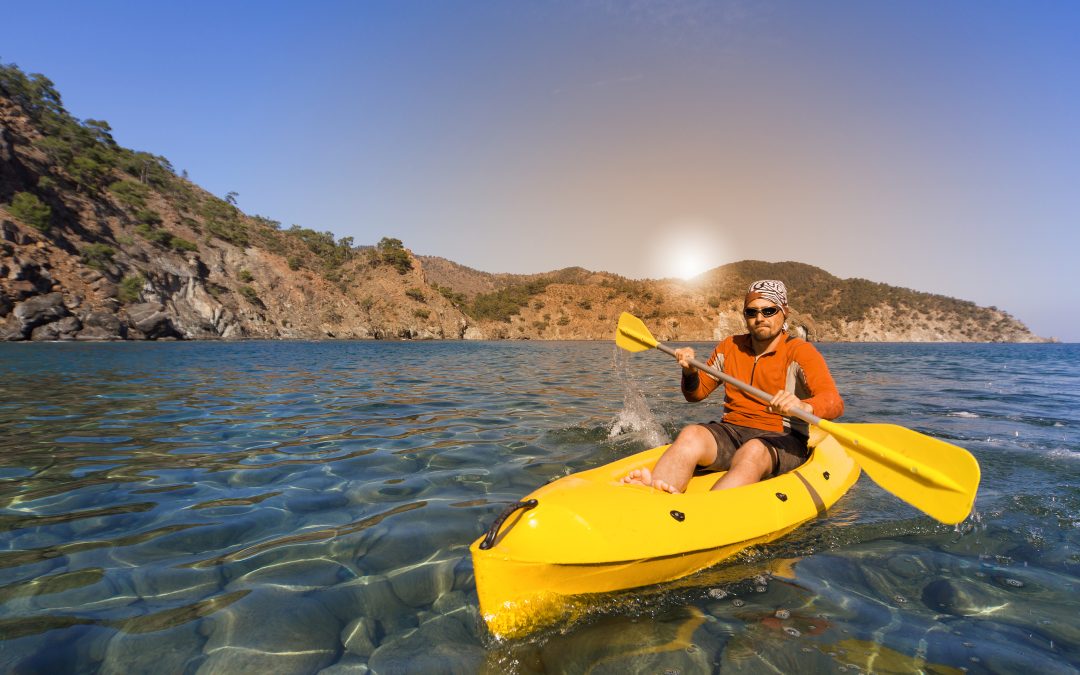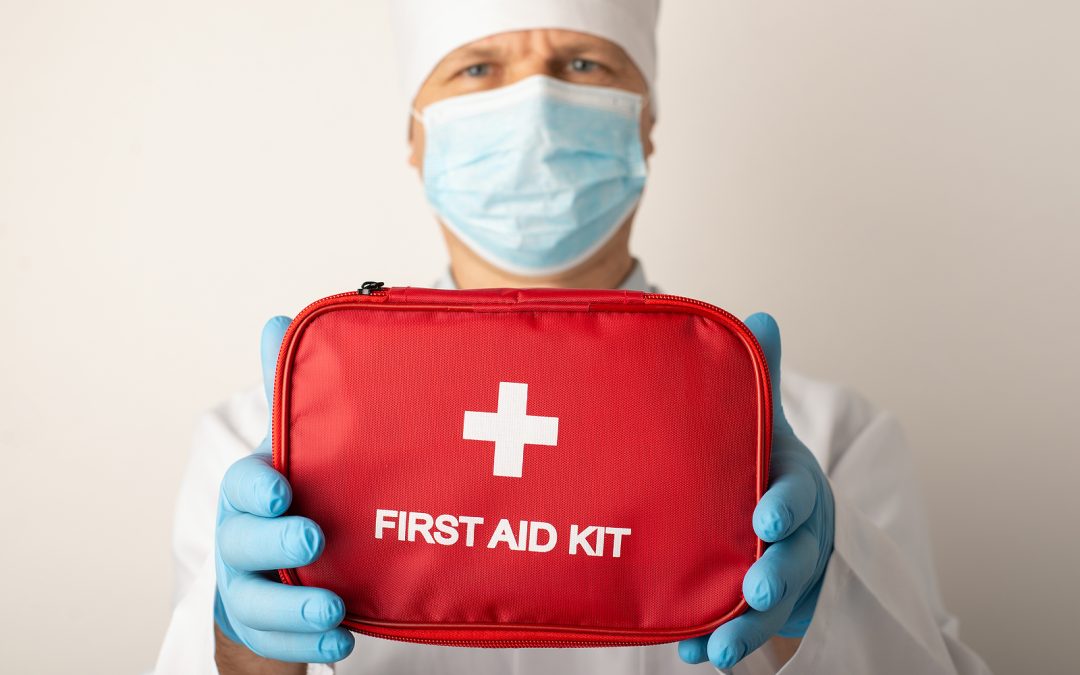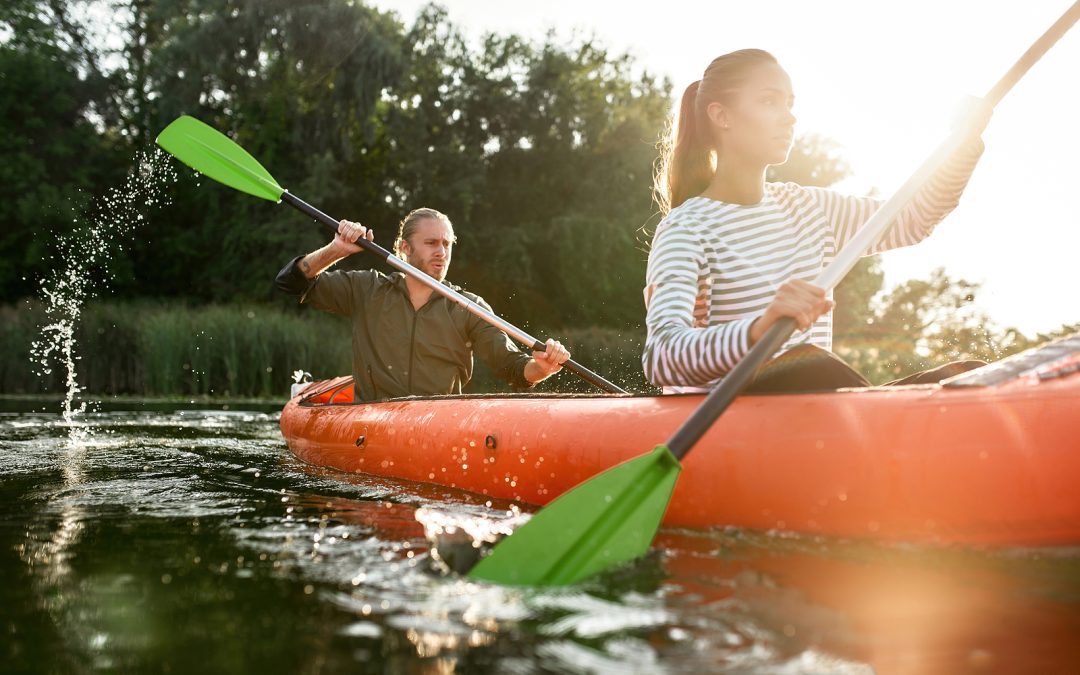Kayaking is more than just an enjoyable water activity; it’s also an excellent full-body workout perfect for anyone looking to improve their fitness levels. One of the primary benefits of kayaking as exercise is that it targets multiple muscle groups, such as the core, shoulders, arms, and even legs while promoting cardiovascular health and improved endurance. With various movements and techniques involved in paddling a kayak, pre-workout warm-up routines, and strength exercises, kayakers of all experience levels can benefit significantly from incorporating this outdoor activity into their fitness regimen.

In addition to being a well-rounded workout, kayaking connects people with nature, offering a mentally refreshing experience away from the typical gym setting. As an outdoor workout, kayaking provides the opportunity to develop essential skills such as balance and coordination while reaping the benefits of fresh air and mental rejuvenation. To maximize the fitness potential of kayaking, enthusiasts can combine it with various strengthening exercises, proper nutrition and hydration, and cross-training activities to enhance performance and reduce the risk of injury.
Key Takeaways
- Kayaking offers a full-body workout that engages multiple muscle groups and promotes cardiovascular health.
- Outdoor kayaking workouts provide a refreshing alternative to traditional gym-based exercises, improving mental well-being.
- Combining kayaking with strength exercises and cross-training helps enhance performance and reduce injury risk.
Benefits of Kayaking for Fitness
Kayaking is a versatile outdoor activity with numerous health benefits, making it an excellent choice for those seeking a full-body workout while enjoying nature. In this section, we will discuss the cardiovascular improvements and full-body muscle engagement that kayaking offers.
Cardiovascular Improvement
Kayaking is an aerobic exercise that promotes a healthy heart and improved cardiovascular health. As you paddle through the water, your heart rate increases, pumping blood more efficiently. Regular kayaking sessions can lead to increased endurance and better overall fitness levels.
For optimal results, it is recommended to engage in kayaking at a moderate pace for an extended duration, ideally 30 minutes or more per session. This approach helps maintain an elevated yet stable heart rate, which results in an effective cardiovascular workout.
Full-Body Muscle Engagement
One critical advantage of kayaking is engaging multiple muscle groups throughout the body. The primary muscles utilized include:
- Arms: Biceps, triceps, and forearms
- Shoulder: Deltoids and rotator cuff muscles
- Back: Latissimus dorsi, trapezius, and rhomboids
- Chest: Pectoral muscles
- Core: Abdominals and obliques
- Legs: Quadriceps, hamstrings, and calves
Each stroke engages your arms, shoulders, back, and chest muscles as you paddle your kayak. Simultaneously, you use your core and lower body muscles for stability and balance while seated in the watercraft.
Although kayaking is predominantly an upper-body workout, the activity also engages the lower body. During a kayaking session, your leg muscles help to maintain balance and support your torso, especially when performing paddling maneuvers like turning or bracing.
In conclusion, kayaking offers an excellent opportunity for a full-body workout targeting a wide range of muscle groups while improving cardiovascular endurance. So, if you’re looking for an enjoyable way to enhance your overall fitness, consider incorporating kayaking into your exercise routine.
Kayaking Technique Fundamentals
Paddle Grip and Control
Kayakers need a proper paddle grip and control to perform an efficient and effective stroke. Start by positioning your hands at a comfortable distance apart, approximately shoulder-width. Your grip should be firm but relaxed, allowing fluid movement while paddling. Ensure that both knuckles are aligned with the blades, facing the same direction, to maintain control during the strokes.
Proper Posture and Torso Rotation
A key aspect of kayaking is maintaining proper posture and using torso rotation to generate force. Sit straight, engaging your core muscles while relaxing your lower back. Your feet should be positioned firmly on the foot pegs, with knees bent and splayed outward. When performing a paddle stroke, rotate your torso rather than relying solely on your arms. This technique utilizes the larger, more powerful muscles in your back and abdomen, reducing fatigue and improving overall efficiency.
Balancing and Bracing on Water
Kayaking requires constant balance and bracing adjustments to ensure water stability. Beginners should practice low-brace and high-brace techniques. Low-brace involves extending the paddle horizontally over the water with the back face of the blade resting on the surface. In contrast, a high brace positions the paddle higher, with the power face of the blade against the water. Both techniques provide support and help prevent capsizing while navigating various water conditions.
By focusing on these fundamentals, kayakers can improve their overall performance, reduce the risk of injury, and increase their enjoyment of this outdoor full-body workout.
Pre-Workout Warm-Up Routines
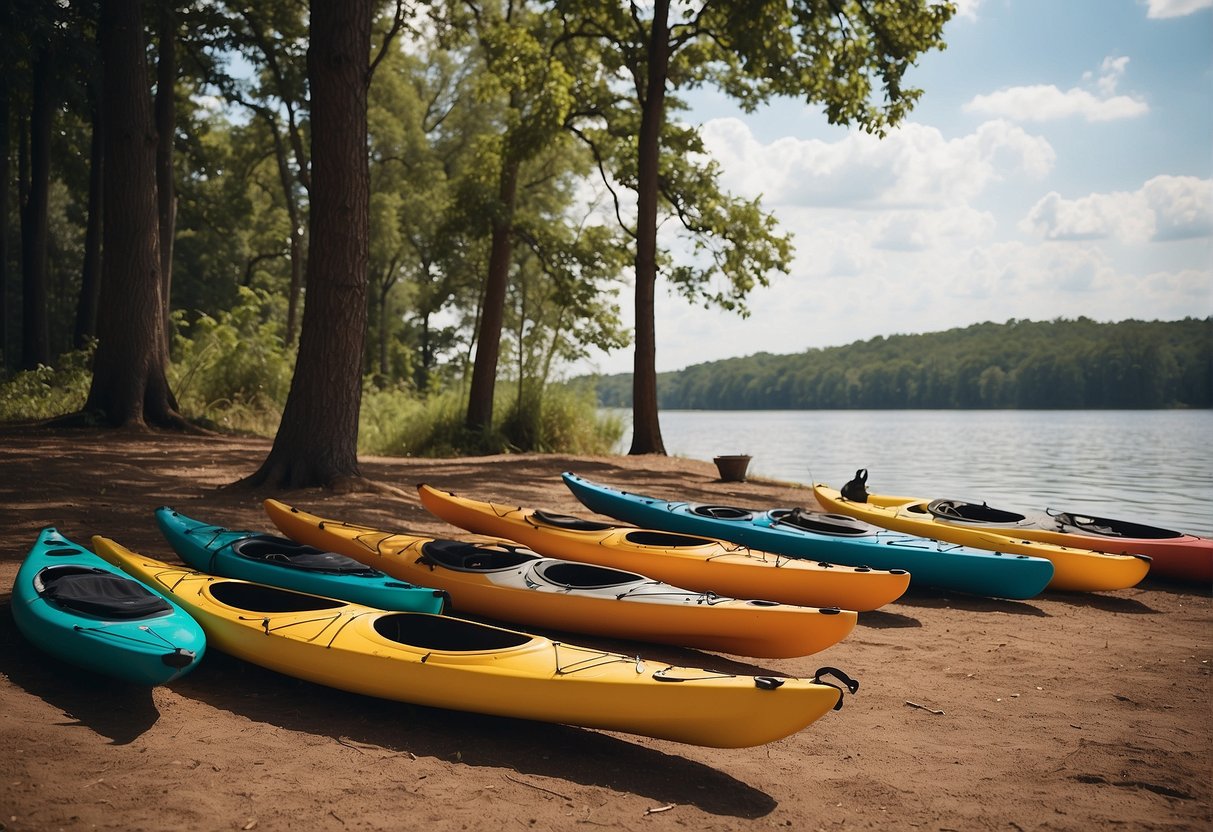
Dynamic Stretching
Dynamic stretching is an essential component of a pre-workout warm-up for kayakers. It helps increase blood flow to the muscles, improves flexibility, and prepares your body for movement. Focus on dynamic stretches targeting the major muscle groups, such as the upper legs, hips, and back.
- Leg swings: Stand next to a wall or support and swing your leg forward and back. Perform ten swings on each leg.
- Arm circles: Extend your arms to the sides and make small to large circular motions. Switch directions after 30 seconds.
- Torso twists: Stand with feet shoulder-width apart and twist your upper body left and right. Perform ten repetitions on each side.
- Lateral lunges: Step to one side, bending the knee of that leg while keeping the other leg straight. Alternate legs for ten repetitions on each side.
Mobility Drills
Incorporate mobility drills into your warm-up routine to increase mobility and activate key muscle groups required for kayaking. REI Expert Advice suggests the following exercises:
- Open book exercise: Lie on your side, with legs in front of you and knees bent at 90 degrees. Both arms should be straight in front of you at roughly shoulder height. Keeping your legs still, slowly open your top arm out to the side to stretch your chest and upper back. Bring the arm back to the starting position and perform 8-10 repetitions before switching sides.
- Hip circles: Stand with feet shoulder-width apart, hands on hips, then make large circular motions with your hips. Perform ten circles in each direction.
- Ankle rolls: Lift one foot off the ground and rotate the ankle in circles. Switch directions after ten rolls, and repeat on the other side.
Integrating these dynamic stretching and mobility drills into your pre-workout warm-up will effectively prepare your body for an engaging, full-body kayaking workout. Remember to focus on your flexibility and mobility, targeting the critical muscle groups needed for efficient and stable kayaking performance.
Core Strengthening Exercises
The core is a group of muscles surrounding the midsection, crucial in kayaking performance. By engaging in core-strengthening exercises, kayakers can improve their balance, stability, and paddling efficiency, ultimately enhancing their overall kayaking experience.
Planks and Oblique Twists
Planks are an excellent exercise for targeting the entirety of the core region. Hold your body in a straight line to perform a plank, balancing on your forearms and toes. Maintain this position for 30 seconds to a minute, progressing as your strength improves. Include variations such as side planks to target oblique muscles as well.
Oblique twists are another effective exercise to strengthen the core muscles. Sit on the ground with your knees bent, holding a weight or a medicine ball in front of your chest. Keep your back straight and twist your torso to one side, then the other, effectively working the oblique muscles. Repeat for 10-15 reps per side.
Stabilizing Movements
In addition to planks and oblique twists, stabilizing movements can help you build a strong core foundation. These exercises are beneficial for improving balance and stability in the kayak.
Russian twists are a great stabilizing exercise. Sit on the floor with knees bent, feet off the ground, and hold a weight or medicine ball at chest level. Twist your torso from side to side, touching the weight on each side’s floor. Complete 10-15 reps per side.
Single-leg deadlifts are another effective exercise for developing core stability. Stand on one leg, holding a kettlebell or dumbbell in the opposite hand. Slowly hinge at the hip to lower the weight towards the ground while extending the non-standing leg back for counterbalance. Keep your core engaged and maintain a neutral spine throughout the movement. Perform 8-12 reps on each leg.
Incorporating these core strengthening exercises into your training regimen will boost strength, stability, and balance, ultimately contributing to a more enjoyable and efficient kayaking experience.
Upper Body Workouts

Shoulder and Arm Strengthening
A key component to successful kayaking is having solid arms and shoulders. One excellent exercise to build strength in these areas is the pull-up. If performed correctly, pull-ups target the lats, biceps, and even the forearms. As a kayaker, incorporating pull-ups into your workout routine can increase paddling efficiency and upper body strength.
To perform pull-ups:
- Begin by finding a stable pull-up bar or horizontal overhead structure.
- Grasp the bar with an overhand grip, hands about shoulder-width apart.
- Hang down entirely, with arms extended and feet off the ground.
- Pull your body up toward the bar, driving your elbows down until your chin clears the top.
- Lower yourself back down slowly and control to the starting position.
Aim to complete three sets of 8-12 pull-ups per workout session. As you progress, consider adding weight or increasing the number of reps for a more significant challenge.
Back and Lat Workouts
Kayakers must develop strong back muscles, specifically the latissimus dorsi, and other supporting muscles. The single-arm bent-over row is a highly effective exercise to target these muscles.
To perform single-arm bent-over rows:
- Stand with your feet shoulder-width apart and a dumbbell in one hand.
- Bend your knees slightly and lean forward at the hips, keeping your back straight and parallel to the ground.
- With your free hand, support your upper body by placing it on your thigh or a bench for stability.
- Begin with your arm hanging straight down, palm facing your body.
- Pull the dumbbell up toward your chest, driving your elbow back.
- Slowly lower the dumbbell back to the starting position.
- Perform three sets of 8-12 reps on each side.
Another effective back and last exercise is the lat pulldown, which can be done using a lat pulldown machine at a gym. This exercise mimics the motion of ppulldowntranslating to better performance.
By focusing on these upper body workouts targeting the arms, shoulders, and back muscles, kayakers can improve their paddling performance and endurance. Make sure to incorporate shoulder and arm strengthening exercises and back and lat workouts into your fitness routine for a well-rounded and effective full-body workout.
Lower Body and Leg Training
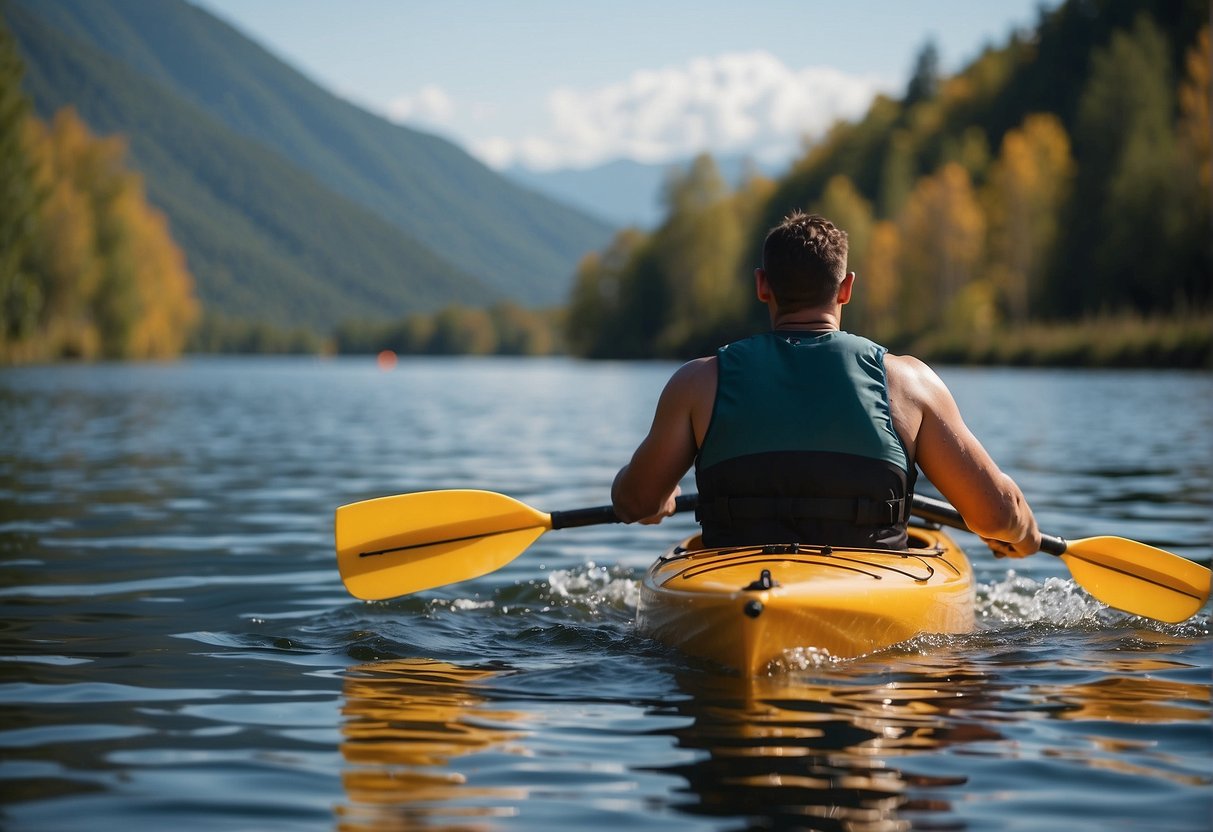
Kayakers must have a strong lower body and leg strength to maintain stability and endurance during long paddling sessions. Lower body exercises such as squats, lunges, and deadlift variations can effectively target these muscle groups and significantly improve kayaking performance.
Squats and Lunges
Squats and lunges are essential for building lower body strength, targeting muscles such as the quadriceps, hamstrings, and glutes. These exercises also engage the core, crucial for maintaining proper form and balance while kayaking.
Basic Squat:
- Stand with feet shoulder-width apart, toes pointing forward
- Keep your chest lifted and your core engaged
- Bend your knees and lower your hips as if sitting in a chair
- Keep your knees behind your toes and maintain a straight back
- Push through your heels to return to the starting position
Lunge:
- Stand with feet hip-width apart, core engaged
- Take a step forward with one leg and lower your hips until both knees are bent at a 90-degree angle
- Keep your front knee above your ankle and your back knee hovering above the ground
- Push through the front heel to return to the starting position and repeat with the other leg
Perform three sets of 12 reps for each exercise.
Deadlift Variations
Deadlifts are another valuable addition to a kayaker’s lower body workout routine. They target the hamstrings, glutes, and lower back, contributing to overall stability and control in the boat. Two common deadlift variations include the traditional deadlift and the Romanian deadlift.
Traditional Deadlift:
- Stand with your feet hip-width apart and toes under the barbell
- Bend at the knees and hips, keeping your chest up, and grasp the barbell with a shoulder-width grip
- Push through your heels, straighten your legs, and lift the barbell while keeping your core engaged and back straight
- Lower the barbell back to the starting position by bending at the hips and knees
Romanian Deadlift:
- Stand with your feet hip-width apart, holding a barbell with a shoulder-width grip
- Keep a slight bend in your knees and your core engaged
- Hinge at the hips and lower the barbell, keeping it close to your body and maintaining a straight back
- Stop when you feel a stretch in your hamstrings, then push through your heels to return to the starting position
Incorporate three sets of 8-10 reps for each deadlift variation into your workout routine for optimal lower body and leg strength development.
Essential Kayaking Movements in the Gym
Kayaking is an exciting outdoor sport that requires a full-body workout to improve overall performance. Incorporating gym exercises that simulate kayaking movements can help one develop strength, endurance, and stability. This section highlights two essential kayaking movements to practice in the gym: Simulated Paddling and Rotational Exercises.
Simulated Paddling
Simulating the paddling movement in the gym primarily involves targeting the muscles used in the actual paddling process. Some critical exercises include:
- Pull-ups: They help strengthen the lats, shoulders, and biceps, essential muscles for a powerful paddle stroke.
- Lat Pulldowns: Another lat-focused exercise mimics pulling the paddle through the water.
- SePulldowns: Focusing on the back, shoulders, and biceps, this exercise helps to improve pulling strength during paddling.
Incorporating these exercises into a gym routine can help kayakers increase their paddling efficiency.
Rotational Exercises
Rotational movements are crucial for efficient kayaking, as they engage the core and help control the kayak while paddling. Some excellent rotational exercises include:
- Russian Twists: This seated exercise targets the obliques and works the rotational aspect of the paddle stroke.
- Medicine Ball Rotational Throws: By throwing a medicine ball against a wall from a rotating position; kayakers can develop their core rotation power, which is essential during quick paddle strokes.
- Cable Rotations: Utilizing a cable machine in the gym, this exercise helps to build rotational strength and endurance using resistance.
Practicing these rotational exercises can significantly impact a kayaker’s overall performance in the water.
Incorporating these essential kayaking movements into a gym routine can help kayakers develop the strength, endurance, and stability needed for peak performance on the water. Regularly practicing these exercises will translate the benefits of gym training into real-world paddling success.
Paddling Specific Strength Exercises
Kayakers need a variety of exercises to improve their strength and overall performance while paddling. This section will focus on two effective workout categories: Resistance Band Drills and Cable Machine Workouts. These exercises target the essential muscles involved in kayaking and will help you build the strength required for efficient and powerful paddle strokes.
Resistance Band Drills
Resistance bands are an excellent tool for improving functional strength, particularly for kayakers. They offer versatile and accessible workouts that can be done anywhere.
- Seated Rows: Sit on the ground with your legs extended. Loop the resistance band around the soles of your feet and hold one end in each hand. Keep your back straight and pull the band toward your chest, engaging your upper back and legs—complete three sets of 15 repetitions.
- Trunk rotations: Stand with your feet shoulder-width apart and hold the resistance band with both hands. Attach the other end of the band to a sturdy anchor point at waist height. Hold the band close to your chest and rotate your upper body while maintaining tension on the band. Focus on engaging your core and obliques while maintaining a neutral spine—complete three sets of 12 rotations on each side.
These resistance band exercises can be easily adjusted to various difficulty levels by altering the band’s thickness or the distance from the anchor point.
Cable Machine Workouts
A cable machine is a versatile gym equipment that allows you to perform various strength exercises. The following workouts target paddling-specific muscles:
- Kayak pulldowns: Attach a straight bar to the high pulley and set an appropriate weight. Facing the machine, pulldowns with both hands and assume an athletic stance. Pull the bar down while engaging your lats and twisting your core, simulating a kayak paddle stroke. Alternate sides and perform three sets of 15 repetitions.
- Standing cable rotations: Attach a handle to the mid-level pulley on the cable machine and set an appropriate weight. Stand sideways to the machine and grasp the handle with both hands at chest level. Rotate your torso away from the machine, maintaining tension on the cable. Engage your core and obliques during this movement. Perform three sets of 12 repetitions on each side.
Incorporating these strength exercises into your training routine will help you develop the necessary power and endurance for kayaking. By focusing on paddling-specific moves with resistance bands and cable machines, you’ll enhance your on-the-water performance and reduce the risk of injury.
Injury Prevention and Recovery
Muscle Soreness Management
Muscle soreness is a common occurrence after intense kayaking sessions. Practicing proper warm-up and cooldown routines can help in reducing muscle soreness. Including dynamic stretches during warm-up and static stretches during cooldown is crucial. Foam rolling is another effective method for alleviating muscle tightness and reducing soreness.
In addition to stretching and foam rolling, utilizing the following strategies can help manage muscle soreness:
- Hydration: Maintain adequate water intake before, during, and after kayaking to help flush out metabolic waste and reduce inflammation.
- Nutrition: Consume a well-balanced diet of antioxidants, proteins, and healthy fats to support muscle recovery.
- Rest: Allow your muscles to recover by giving them sufficient rest time between kayaking sessions.
Correcting Muscular Imbalance
Kayaking mainly targets the muscles in the upper body, which can potentially lead to muscle imbalances if the lower body and core muscles are not adequately strengthened. Incorporating a variety of strength training exercises can help to address such imbalances. Consider including the following exercises in your routine:
| Exercise | Target Muscles | Description |
|---|---|---|
| Pull-ups | Back, biceps | Strengthen the upper body muscles required for efficient paddling. |
| Push-ups | Chest, triceps | Improve pushing strength and balance the development of upper body muscles. |
| Lunges | Legs, glutes | Strengthen the lower body muscles, improving overall stability. |
| Russian twists | Core, obliques | Increase core strength, which is essential for maintaining an upright posture. |
| Seated row | Back, shoulders | Enhance the pulling strength of the back and shoulders, which is crucial for kayaking. |
A well-rounded training program can help reduce the risk of injuries and muscle imbalances while boosting overall kayaking performance. Incorporate these strategies for injury prevention and recovery, ensuring a safe and practical experience in the water.
Designing Your Workout Program
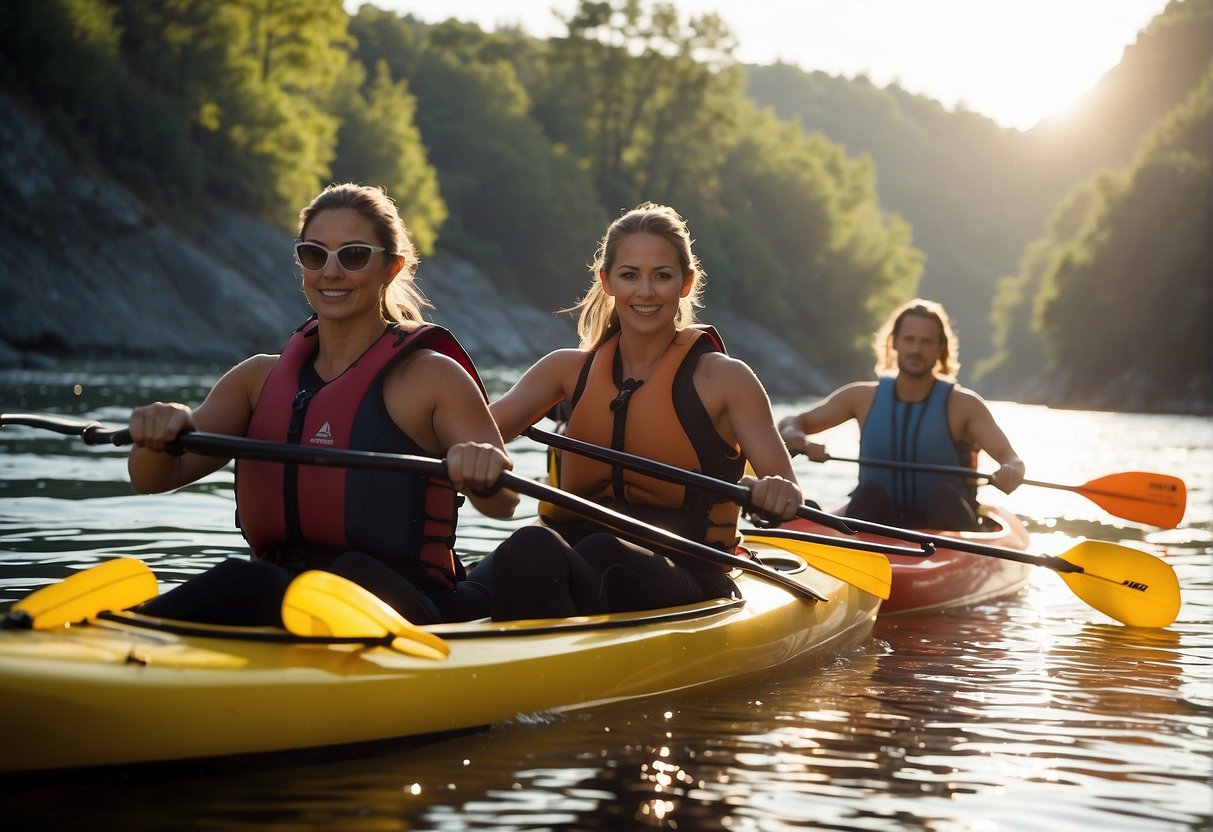
Weekly Training Split
A well-rounded kayaking workout program should include cardiovascular exercises, strength training, and flexibility. Aim for at least three days of cardio and two days of strength training and flexibility exercises throughout the week.
Here’s a sample weekly training split:
- Monday: Cardio (e.g., paddling, swimming, or jogging)
- Tuesday: Strength training (e.g., pull-ups, push-ups, and lunges)
- Wednesday: Rest or light cardio (e.g., walking or stretching)
- Thursday: Cardio
- Friday: Strength training
- Saturday: Rest or light cardio
- Sunday: Cardio or active rest (e.g., yoga or core exercises)
*Note: Listen to your body and adjust the schedule as needed.
Periodization and Intensity
Periodization is an essential aspect of any fitness program, especially for kayakers. It involves gradually increasing the training intensity and volume, followed by a planned recovery period.
A kayaking training program can be divided into the following stages:
- Base building: Focus on endurance, aerobic capacity, and technique improvement. Start with lower-intensity workouts and gradually increase the volume.
- Strength and power development: Introduce strength exercises and increase the intensity of your workouts. Focus on exercises targeting the muscles used in kayaking, such as the back, shoulders, and core.
- Race preparation or peak performance: As you get closer to a race or event, increase the intensity of your workouts and include race-specific training, such as interval workouts and time trials.
- Taper and recovery: Before an event, reduce training volume, maintain intensity, and allow your body to repair and adapt.
By incorporating a periodization plan and adjusting the intensity levels throughout the training program, kayakers can optimize their fitness, reduce the risk of injury, and enhance their overall performance on the water.
Nutrition and Hydration for Kayakers
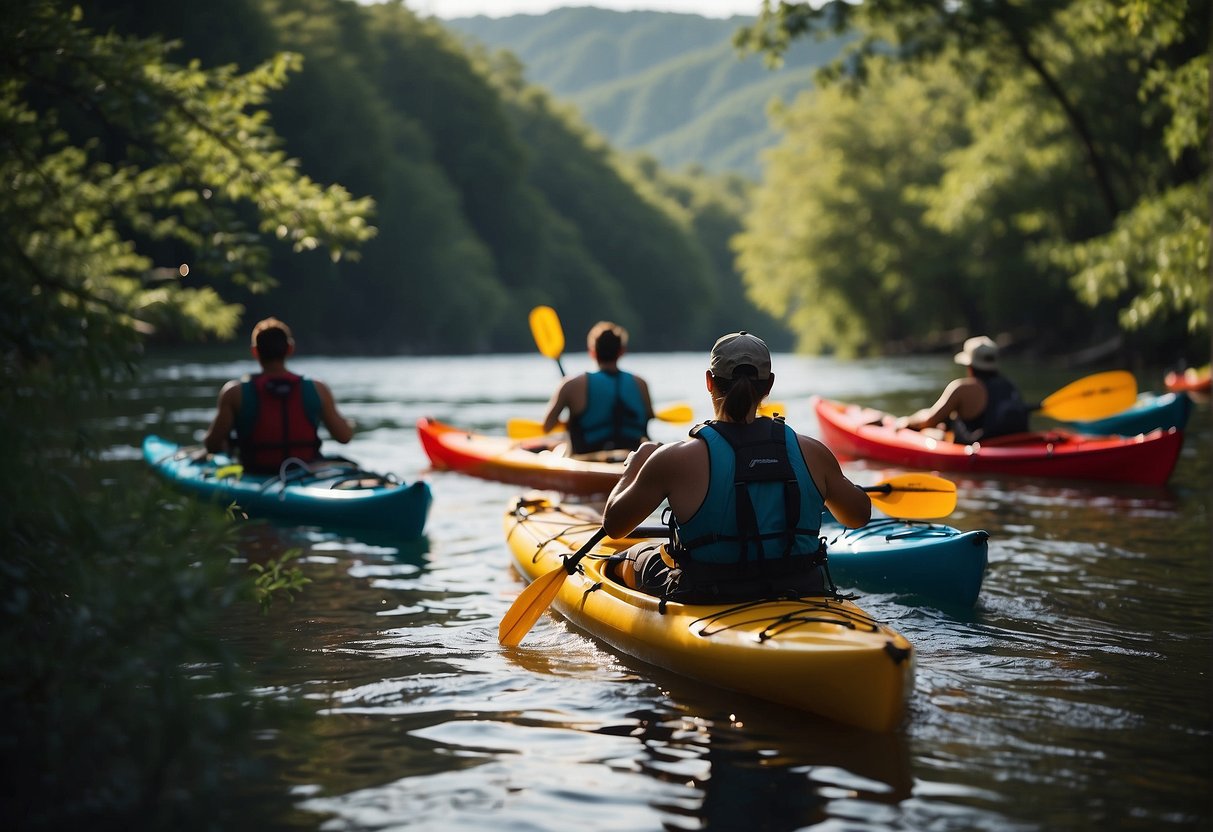
Energy Sustenance
Proper nutrition is crucial for kayakers, providing the energy to sustain prolonged physical activity. Consuming a balanced diet, focusing on carbohydrates, is critical to maintaining energy levels. Carbs act as the body’s primary fuel source, so it is recommended that kayakers include whole grains, fruits, and vegetables in their diet.
Other essential macronutrients, such as proteins and fats, should not be overlooked. Proteins help build and repair muscles, while healthy fats help support overall body functioning. A kayaker’s diet should include lean meats, fish, nuts, and seeds to ensure an adequate intake of proteins and fats.
Hydrating before, during, and after paddling is essential. Hydration is vital in maintaining body temperature, preventing cramping, and promoting overall health. Kayakers must drink plenty of water throughout the day and consider supplementing with electrolyte drinks during prolonged exercises, especially in hot weather. Remember, staying hydrated helps sustain the optimum energy levels required for an effective full-body workout.
The Importance of Vitamin D
While out on the water, kayakers are getting a full-body workout and soaking up Vitamin D. Known as the “sunshine vitamin,” Vitamin D is synthesized in the skin when exposed to sunlight and plays a crucial role in bone health, immunity, and mood regulation.
Kayakers should ensure they get enough Vitamin D through sun exposure, food sources, and supplements as needed. Some dietary sources of Vitamin D include fatty fish, fortified dairy products, and egg yolks. A daily Vitamin D supplement would benefit those with limited sun exposure, such as people living in northern latitudes or those with limited outdoor time.
In conclusion, a well-rounded diet, proper hydration, and sufficient Vitamin D levels are crucial for kayakers looking to get the most out of their outdoor full-body workouts. These nutritional components are essential in sustaining energy, ensuring safety, and promoting overall health.
Cross-Training for Enhanced Performance
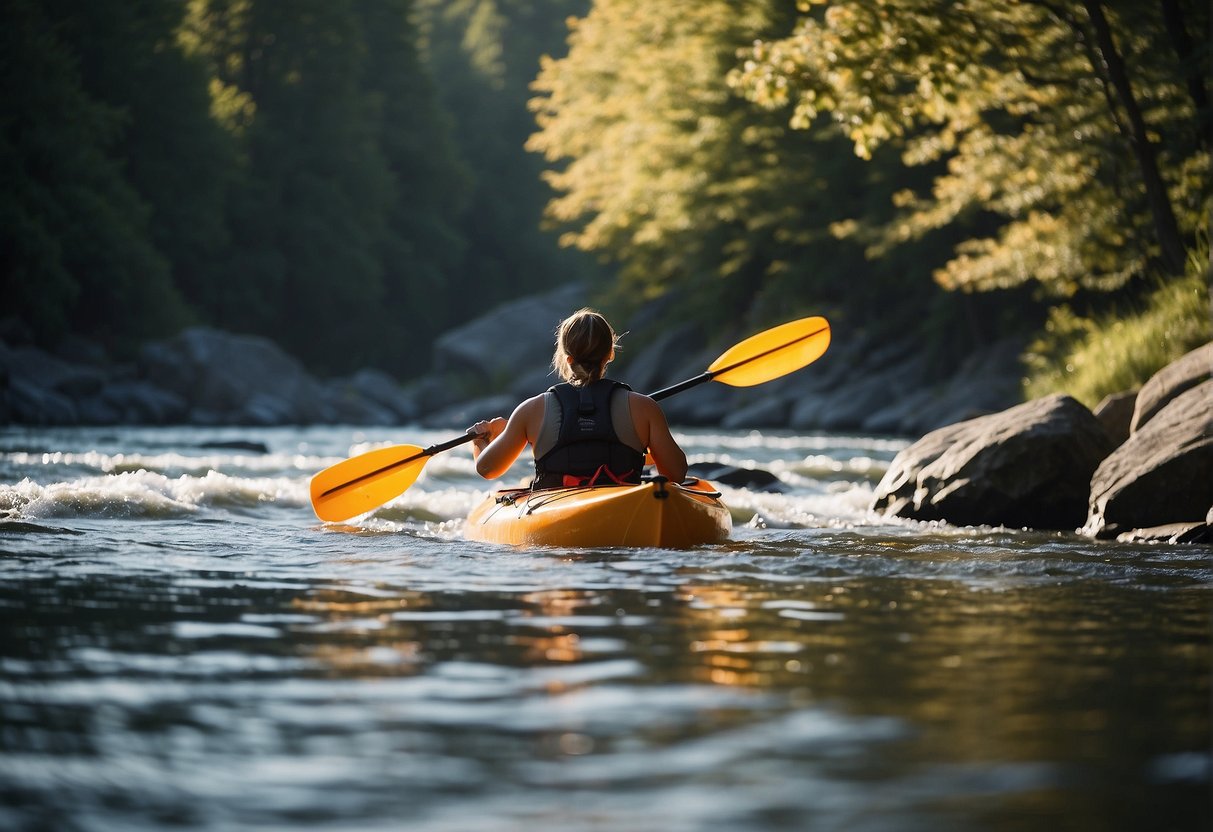
Cardio and Strength Balance
Cross-training is essential to a kayaker’s fitness routine for improving overall performance. One can effectively balance endurance, stamina, and muscular power by incorporating cardio and strength workouts. A good cardio workout, such as swimming, enhances stamina and helps develop strong swimming skills, which are vital for kayakers.
On the other hand, strength exercises like pull-ups and push-ups boost upper body development, stability, and balance. This balance between cardio and strength training helps to:
- Increase paddling efficiency
- Enhance stability and balance
- Improve overall endurance
- Prevent injuries
- Boost confidence and mental resilience
To achieve an optimal balance, kayakers can follow a simple weekly workout routine:
- Monday: Cardio workout (e.g., swimming, running, cycling)
- Tuesday: Strength training (e.g., pull-ups, push-ups, lunges)
- Wednesday: Rest day
- Thursday: Cardio workout
- Friday: Strength training
- Saturday: Rest day
- Sunday: Optional cross-training activity (e.g., yoga, Pilates, hiking)
Alternating Workout Modalities
In addition to balancing cardio and strength workouts, alternating between different workout modalities can contribute to better performance. Cross-training activities such as yoga, Pilates, or hiking can help improve balance, flexibility, and core strength.
Implementing a variety of workout modalities ensures that muscles and joints get trained differently, preventing overuse injuries and promoting overall fitness. To integrate various workout modalities, kayakers can follow this example routine:
- Week 1:
- Monday: Swimming
- Tuesday: Push-ups and lunges
- Wednesday: Rest
- Thursday: Cycling
- Friday: Pull-ups and seated row
- Saturday: Rest
- Sunday: Yoga
- Week 2:
- Monday: Running
- Tuesday: Lat pulldowns and lunges
- Wednesday: Rest
- Thursday: Swimming
- Friday: Push-ups and seated row
- Saturday: Rest
- Supulldownsates
By strategically alternating workout modalities, kayakers can continually challenge their bodies and minds, enhancing overall performance and ensuring long-term fitness improvements.
Safety Considerations for Outdoor Workouts
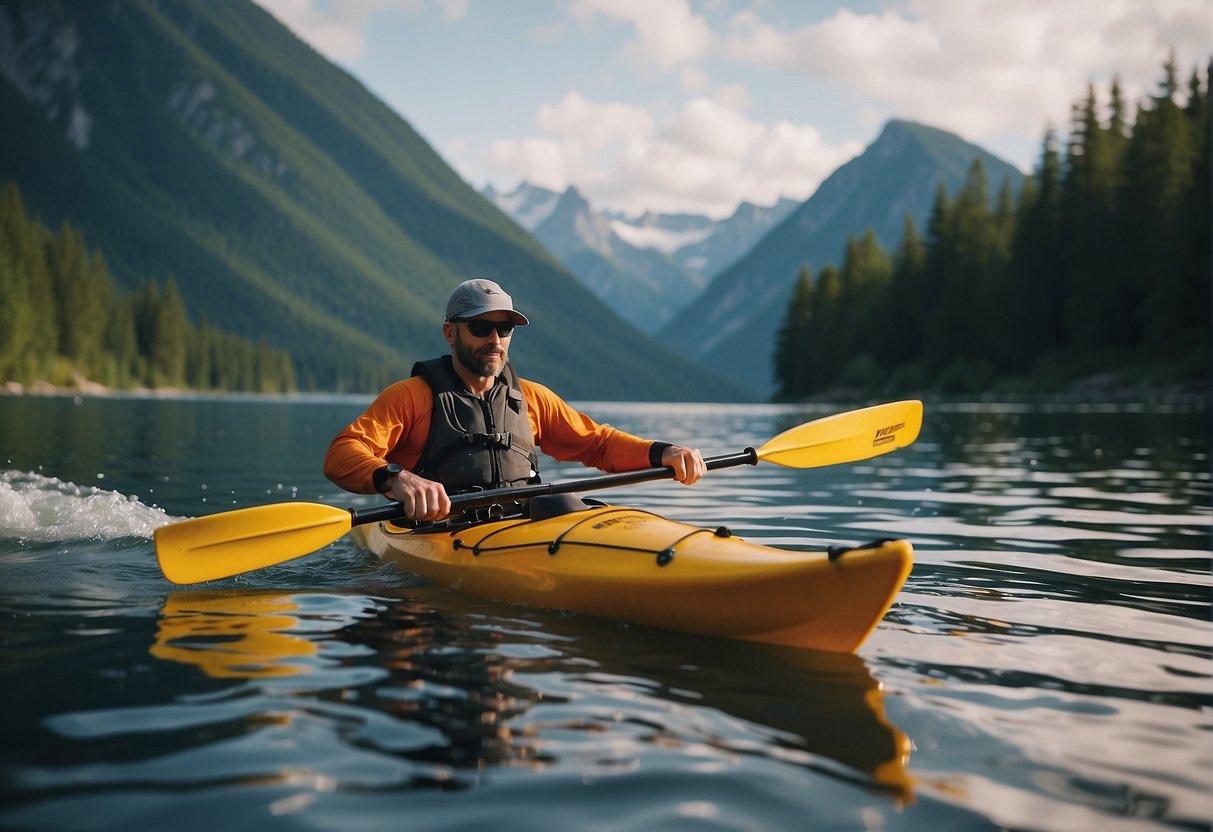
Gear and Equipment
When kayakers plan an outdoor full-body workout, they must use the appropriate gear and equipment for safety. Always wear a helmet and life jacket while kayaking or participating in water-based workouts. Invest in proper footwear to ensure a secure grip during outdoor exercises. Additionally, using high-quality paddles that suit your skill level and body type will help reduce the risk of injuries.
Kayakers should regularly inspect their equipment for wear and tear to avoid accidents or breakdowns. Replace damaged gear as needed to maintain optimal safety.
Weather and Environmental Factors
Weather conditions significantly influence the safety of outdoor workouts for kayakers. Be aware of the potential risks associated with exercising in cold or hot weather, and modify your activities as needed.
- Cold weather: Dress in layers to keep warm and dry. Choose moisture-wicking fabrics that prevent sweat build-up and maintain body temperature. Avoid extreme cold temperatures as they can lead to hypothermia or frostbite.
- Hot Weather: Stay hydrated and wear lightweight, breathable clothing to prevent overheating. Limit outdoor workouts during high heat or direct sun exposure.
Before starting your workout, check local weather forecasts and adjust your plans accordingly. Moreover, be aware of the environmental conditions at your chosen workout location. For instance, if you’re kayaking in new waters, research the area for potential hazards, such as rocks, rapids, and dangerous wildlife.
By taking the necessary precautions with gear, equipment, and environmental factors, kayakers can safely enjoy their outdoor full-body workouts, minimizing the risk of injury and accidents.
Monitoring Progress and Adaptation
Tracking Fitness Metrics
Monitoring your progress is vital for ensuring the effectiveness of your outdoor full-body workout for kayaking. Track essential fitness metrics, such as strength, endurance, and flexibility, to assess improvements over time. By documenting your performance, you can identify areas that need attention and set achievable goals for continuous growth. Below is an example of a simple table to help record and monitor your progress:
| Date | Push-ups | Plank Hold | Pull-ups | Hamstring Stretch |
|---|---|---|---|---|
| Jan 1, 2024 | 10 | 30s | 5 | 20s |
| Jan 5, 2024 | 12 | 35s | 6 | 22s |
| Jan 10, 2024 | 15 | 40s | 8 | 25s |
For tracking endurance, consider using a GPS-enabled waterproof watch while kayaking. This tool can measure distance, speed, and heart rate, crucial factors when evaluating aerobic fitness.
When to Modify Your Routine
Adaptation is essential for long-term success in any fitness program. As you become more proficient in your outdoor full-body workout for kayaking, it is crucial to modify your routine to continue challenging your body and avoid plateaus.
Notice when specific exercises become less challenging or when you reach your goals in specific metrics. In these cases, make adjustments by increasing the intensity and volume or incorporating new exercises to target specific areas of weakness.
For example, once you can easily accomplish 15 push-ups, consider transitioning to more challenging variations, such as decline or plyometric push-ups.
Remember that kayaking requires a balance of strength, endurance, and flexibility to optimize performance. Continuously reassess your progress and make adaptations to maintain improvement and reach your potential on the water.
Frequently Asked Questions
What are practical strength training exercises for kayakers to perform outdoors?
Some practical outdoor strength training exercises for kayakers include kettlebell swings, lunges with twists, and functional bodyweight exercises like push-ups and squats. These exercises focus on strengthening core, upper, and lower body muscles commonly used during kayaking.
How can kayakers achieve a full-body workout when training at home?
A full-body workout at home can be achieved through bodyweight exercises, like planks, crunches, and twists, and resistance training using resistance bands or household items like water bottles. Maintaining a regular workout routine targeting all the major muscle groups will help kayakers improve their overall fitness and performance.
Which exercises are best for improving kayakers’ performance and endurance?
Some practical exercises for improving kayakers’ performance and endurance include planks, twisting exercises, and rowing machine workouts. These exercises target the core, upper body, and arms, mimicking the movements used while kayaking and helping to build muscle endurance and cardiovascular fitness.
What is a good body conditioning routine for kayakers looking to transform their physique?
A well-rounded body conditioning routine for kayakers should focus on improving mobility, flexibility, strength, and endurance. Combining strength training, cardiovascular training, and stretching exercises, such as cat/cow stretches or yoga routines, can help kayakers achieve a muscular and functional physique.
How can kayakers develop the necessary upper and lower body strength for paddling?
Upper and lower body strength is essential for kayakers navigating through water. Strength training exercises like push-ups, pull-ups, squats, and lunges can help build upper and lower body strength. Compound moves involving multiple muscle groups, such as deadlifts and bent-over rows, can also help develop the necessary strength for paddling.
What are the recommended practices for safe entry and exit from a kayak?
The key to safe entry and exit from a kayak is maintaining balance and following proper technique. Ensure the kayak is stable and parallel to the shore before entering or exiting. Grip the paddle with both hands, using it as a support by placing it across the cockpit, and slide into or out of the kayak with a controlled movement. Practicing these techniques regularly is essential to make the process smooth and safe.
Conclusion
Kayaking offers an excellent opportunity for outdoor enthusiasts to engage in a full-body workout while enjoying nature. The activity targets various muscle groups, including the arms, back, shoulder, and core muscles, contributing to enhanced paddling efficiency and overall fitness1.
One of the benefits of kayaking is the low-impact nature of the exercise. It is accessible on the joints and suitable for people of all ages and fitness levels. Furthermore, regular kayaking sessions can increase endurance and improve balance, making it an ideal workout for casual paddlers and seasoned athletes.
Strength training exercises focusing on the core muscles, latissimus dorsi, forearms, wrists, legs, hip flexors, triceps, and biceps can further help enhance a kayaker’s performance3. These exercises ensure proper muscle engagement during kayaking and aid in injury prevention and building mental resilience.
To maximize the benefits of kayaking as a workout, practicing proper paddling techniques and maintaining awareness of body posture is essential. Combining warm-up and cooldown exercises with strength training for kayaking can lead to better and more lasting fitness results.
In summary, kayaking provides a unique and enjoyable full-body workout experience. Combining the activity with strength training and proper techniques can help individuals achieve their fitness goals while reducing the risk of injury. With regular practice, kayakers can enjoy increased paddling efficiency, enhanced stability, and improved well-being.





